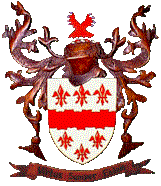

| Signature and Artists use |
ArtLex (www.artlex.com) is the source of this quotation, |
||
| signature, signed and unsigned - A signature is a
person's name as written by that person, as distinguished from how anyone
else would sign either that person's name or their own name. A signature on
an artwork usually establishes the identity of its maker. Just as the names of people take various formal and informal styles, artists have been known to sign their works in a great variety of ways. Signing marks have sometimes been the initials of an artist's name (a monogram perhaps), or an impression from a stamp (as in the chop marks of Chinese and Japanese painters, and many ceramic and metal workers), or a symbol (as in James A. M. Whistler's butterfly). Expanding or accompanying a signature might be the title of the work, an inscription (a dedication or explanation perhaps), a date, initials signifying membership in an artist's organization ("RA" for Royal Academy or "AWS" for American Watercolor Society for instance), or the receipt of an honour. Caricaturist Al Hirshfeld (American, 1903-2003) often placed a number after his signature, telling us how many times he'd hidden his daughter Nina's name in that drawing. Students may need to add a mark identifying the class they're in. Signatures have been placed in many locations on works. Most commonly on drawings and paintings, signatures have been placed just inside the bottom or top edge of the picture. Paintings have been signed in all other areas of pictures, as well as on their backs, stretchers, and frames. When siting a signature deep within a picture, artists have used many sorts of moderating ploys: placing them within cartouches, or on what appears to be a scrap of paper, or in the embroidery on a figure's clothing, etc. Printmakers have been known to sign within a print's block or plate, or on its support outside of the image. Typically artists sign works only when they've been finished. Signing a work is frequently the gesture marking a work's completion â ‚¬ €ť the moment, as Picasso put it, that it is ready to be "abandoned." There are many reasons why an artist might neglect or refuse to sign some works. Often artists have left unsigned works that weren't fully done. Similarly, artists have not signed works when the quality of those works did not meet their standard for signed works. We prize the appearance of the artist's signature on a work for these reasons, but also because it helps to establish the artist's participation in its making. It helps to establish the authenticity and the importance of a work. Consequently the presence of a signature tends to support the market value of a work. The owners of works of art can feel a justified need to mark their art possessions with their identities, most often because of the need to keep possessions secure. The owners of books wish their libraries to remain intact (picture the ex libris on bookplates), but the later owners of those books can find those bookplates and other marks a mixed blessing. Mark ownership of art possessions with great caution. Because no one lives forever, consider the reversibility / permanence of the label, its size, and position. Owners have most frequently labelled the backs, frames, undersides, and other unobtrusive parts of works. In Chinese and Japanese tradition, both the makers and connoisseurs of paintings have marked the front sides of works with chops. In the history of forgeries, many artists' signatures have been falsified. This has been done on forged works of course, but also on pieces artists worked on but did not sign. Thinking of signatures more metaphorically, an artist's style is sometimes considered his/her signature. When an artist is highly exclusively associated with a favoured shape, colour scheme, brushstroke, medium, content, or some other characteristic, it could be thought of as marking works as his/hers. Among the problems artists have had with signatures: An illegible, ambiguous, or incomplete signature can make it difficult for a patron, art historian, or educator to establish the identity of an artist. A signature can be such a focal point as to interfere with a viewer's experience of a work. It might prevent reification. Artists are typically careful to control their signatures' colour, size, style, and location. In bookbinding, a signature is a sheet after it's been folded. When signatures were folded by hand, the folders initialled their work; hence the word "signature." Also called a signature, but more commonly marking the foot of the first page of each folded sheet or section (a section being a "gathering" or "quire" of signatures within one fold, producing 4, 8, 12, 16, or more pages), are letters or numbers indicating the order in which each section should be bound. In large books, after the alphabet has been used once, traditionally bookbinders continue AA or 2A, etc. Sometimes both letters and numbers are used at the same time. When pages are paginated, such signatures are unnecessary. |
|
-
Art Dictionary for artists, collectors, students and educators in art
production, criticism, history, aesthetics, and education |

Discount online artist materials
Dodgson Fine Arts Limited
Registered in Cardiff: No. 2790288
Back to Hints and Tips Index page
For further information and help
please telephone 01524 68014 between 9 am and 5 pm Monday - Saturday
or email help@studioartshop.co.uk
Registered Office:
50 North Road Lancaster England LA1 1LT
Tel: +44 (0)1524 68014
VAT No. 155 6324 65
Copyright © Studio Arts. All Rights Reserved.